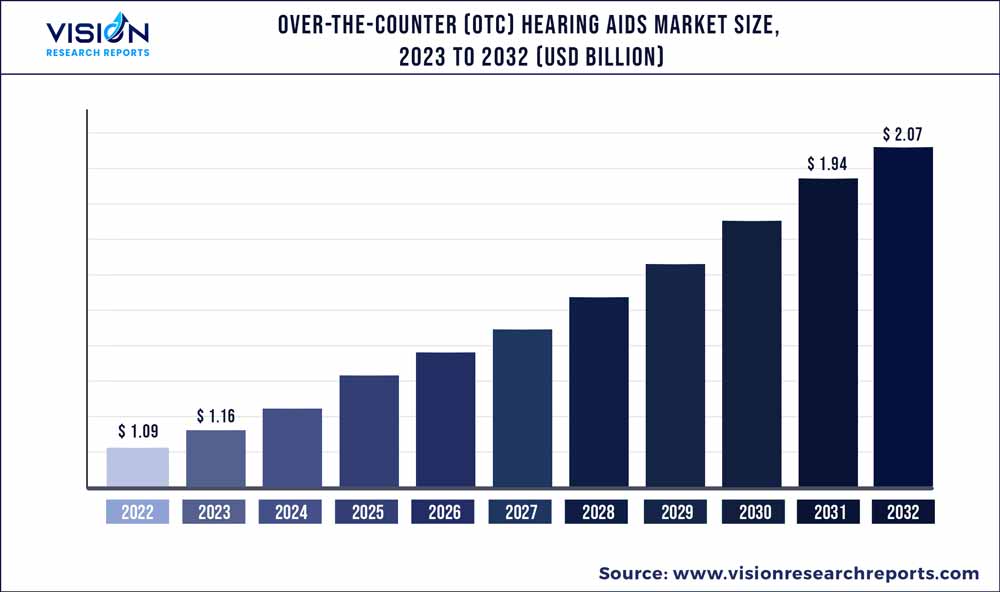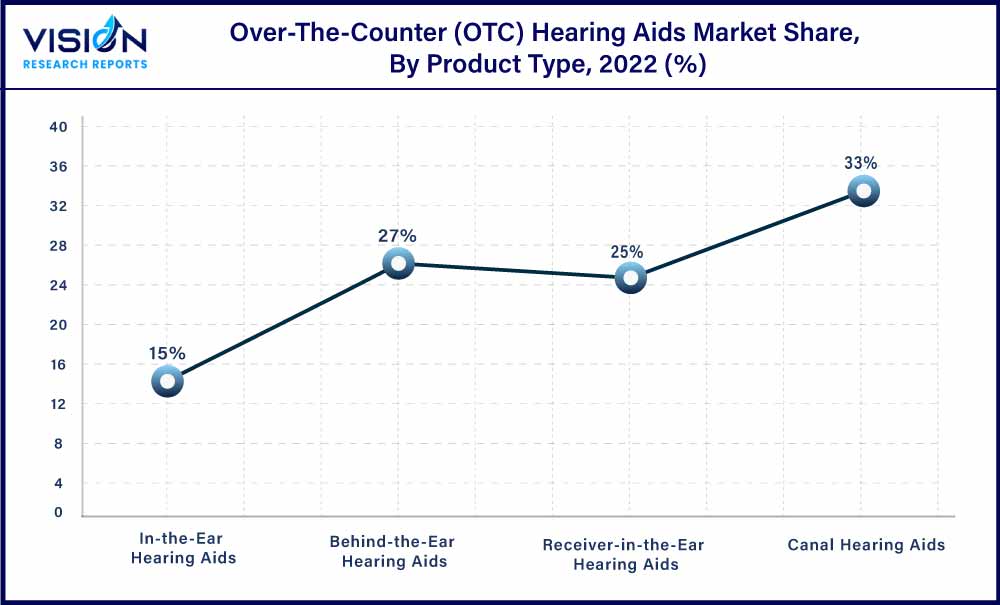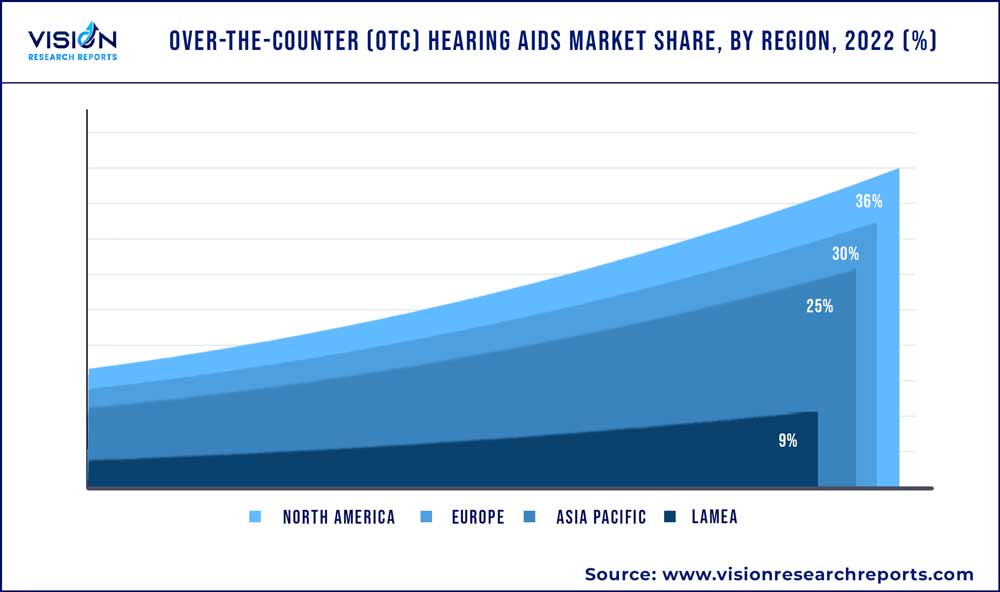The global over-the-counter (OTC) hearing aids market size was estimated at around USD 1.09 billion in 2022 and it is projected to hit around USD 2.07 billion by 2032, growing at a CAGR of 6.63% from 2023 to 2032. The over-the-counter (OTC) hearing aids market in the United States was accounted for USD 327.6 million in 2022.

Key Pointers
Report Scope of the Over-The-Counter (OTC) Hearing Aids Market
| Report Coverage | Details |
| Revenue Share of North America in 2022 | 36% |
| Revenue Forecast by 2032 | USD 2.07 billion |
| Growth Rate from 2023 to 2032 | CAGR of 6.63% |
| Base Year | 2022 |
| Forecast Period | 2023 to 2032 |
| Market Analysis (Terms Used) | Value (US$ Million/Billion) or (Volume/Units) |
| Companies Covered | Eargo, Inc.; Jabra; MD Hearing; Audicus; Sony Corporation; Start Hearing; and Lexie (hearX IP (Pty) Ltd.) |
OTC hearing aids have lower prices when compared to prescription ones and hence are more affordable. This is one of the important factors responsible for their growing demand. The average price of prescription hearing aids is around USD 4,600, while OTC cost around USD 1,600. Furthermore, Medicare and many insurance companies do not cover the cost of hearing aids. Some insurance providers offer coverage as add-on services, but the patients are required to pay extra premiums.
Hearing loss or impairment is common among patients, especially in industrialized countries. As per WHO, over 1.5 billion people across the globe live with some level of hearing loss. This figure is expected to reach 2.5 billion by 2050. Furthermore, over 460 million people across the globe, representing around 5% of the global population, are living with disabling hearing loss. This is expected to increase to over 700 million or 1 in every 10 people by 2050. This is mainly due to increasing life expectancy and rising noise pollution, which is leading to a high incidence of age-related auditory impairment.
With the increasing demand for OTC hearing products, many companies are entering the market by launching technologically advanced products. Many manufacturers offer products that can be embedded deep in the ear, thereby hiding them from view. The latest Behind-the-Ear (BTE) and Invisible-in-Canal (IIC) are available in small sizes, which are not easily visible. These aids fit very close to the eardrum, hence requiring less power while delivering natural and clear sound. Many manufacturers launching canal hearing aids that are discreet. For instance, in October 2022, Lexie (hearX IP (Pty) Ltd.) announced the release of the Lexie B2, a receiver-in-canal OTC hearing aid in the U.S.
The COVID-19 pandemic had a positive impact on the market, with an increase in consumer awareness about OTC hearing aids and its benefits that led to high adoption. Lockdowns imposed across nations and increased restrictions on in-person activities, particularly among the geriatric population that need audiology devices the most, are factors driving the market. OTC hearing aids do not require any visits to audiologists or ENT specialists and can be easily purchased online, which favored sales during the pandemic. For instance, Eargo, Inc.’s revenue in the year 2020 increased by 111%, due to high demand during the COVID-19 pandemic.
Product Insights
The canal hearing aids segment held the largest market share of 33% in 2022. Technological advancements, new product approvals, and advantages, such as compact design, are factors driving segment growth. Moreover, increasing R&D initiatives undertaken by the key players in order to improve their performance and rising demand for invisible devices by the younger population are some of the key factors, which are expected to boost their acceptance.

The behind-the-ear segment is anticipated to witness lucrative growth during the forecast period owing to the advantages offered by these devices such as feedback management, noise reduction, and multiple listening environments which is expected to drive demand for these devices. Moreover, the devices can be modified by connecting with external sound sources and are Bluetooth compatible which enables wireless connectivity. Further, the devices offer higher amplification and feature larger battery life, which is expected to further contribute to the demand for behind-the-ear devices.
Receiver-in-the-Ear (RITE) devices feature receivers that can be placed inside the ear, thus allowing the device to be smaller than BTE. RITE devices have several advantages including availability in mini and micro sizes, efficient sound transmission directly into the ear canal, invisible when worn due to their small size. In addition, these devices are available with the option of standard domes or custom earmolds.
Technology Insights
The digital segment accounted for the largest revenue share of 94% in 2022. Technological advancements and increased preference for digital audiology devices compared with analog ones are boosting the segment growth. These devices offer enhanced flexibility in programming for matching the transmitted sound to the needs of a specific pattern of hearing loss. In addition, they provide multiple program memories. They have several advantages over traditional analog devices, which include directional microphones, feedback reduction, signal processing, speech enhancement, and noise reduction.
In addition, companies are developing a new generation of digital audiology devices along with innovative technology, improving compatibility, and incorporation along with IT devices, thus favoring segment growth. Furthermore, increased awareness about digital devices and their usage also resulted in market growth in both developed and emerging countries.
The analog segment is expected to have moderate market growth. These devices work by increasing the intensity of continuous sound waves. All sounds, including speech & noise, are uniformly amplified by them. Due to low cost and a small number of resistant customers, manufacturers have been making and selling analog audiology devices.
Distribution Channel Insights
The retail stores segment accounted for a major market share of 40% in 2022. This can be attributed to factors such as a rise in the number of manufacturing companies partnering with retail store owners, a large number of retail stores across various locations, and high retail sales margins. The FDA's rule permits stores to sell hearing aids over the counter to millions of customers at lower prices. Retailers can make the most of this exceptional opportunity.
The online segment is anticipated to witness lucrative growth during the forecast period. Cost efficiency, ease of use, and availability are driving the segment growth. Manufacturers are adopting online platforms as the products reach directly to customers eliminating the players in between increasing their profits.
Regional Insights
North America dominated the market in 2022, accounting for the largest market share of 36%, and is anticipated to maintain its position throughout the forecast period. The availability of favorable government policies and the high prevalence of mild auditory impairment is expected to be the key factors driving the market in North America. For instance, according to the National Institute on Deafness and Other Communicable Disorders, about 18% of the population between the ages of 20 and 69 suffer from audio-frequency hearing loss in one or both ears in the U.S. About 28 million American adults can benefit from hearing aids, which is expected to contribute to market growth.

Asia Pacific is expected to register remarkable growth during the forecast period The market in Asia Pacific is primarily driven by high demand in China and Japan. This is due to the local presence of major market players and the large geriatric population. China is anticipated to be the fastest-growing market during the forecast period in Asia Pacific, with South Korea and India as some of the key emerging economies.
Asia has the highest population density in the world and most likely the largest number of individuals with hearing loss. In 2021, WHO predicted that 401 million people in the WHO Southeastern Asia have some degree of hearing loss, and 109.4 million individuals, or 5.5% of the population, have a moderate or severe loss. Furthermore, this figure is expected to reach 666 million by 2050 in Southeastern Asia.
Over-The-Counter (OTC) Hearing Aids Market Segmentations:
By Product Type
By Technology Type
By Distribution Channel
By Regional
Chapter 1. Introduction
1.1. Research Objective
1.2. Scope of the Study
1.3. Definition
Chapter 2. Research Methodology
2.1. Research Approach
2.2. Data Sources
2.3. Assumptions & Limitations
Chapter 3. Executive Summary
3.1. Market Snapshot
Chapter 4. Market Variables and Scope
4.1. Introduction
4.2. Market Classification and Scope
4.3. Industry Value Chain Analysis
4.3.1. Raw Material Procurement Analysis
4.3.2. Sales and Distribution Product Type Analysis
4.3.3. Downstream Buyer Analysis
Chapter 5. COVID 19 Impact on Over-The-Counter (OTC) Hearing Aids Market
5.1. COVID-19 Landscape: Over-The-Counter (OTC) Hearing Aids Industry Impact
5.2. COVID 19 - Impact Assessment for the Industry
5.3. COVID 19 Impact: Global Major Government Policy
5.4. Market Trends and Opportunities in the COVID-19 Landscape
Chapter 6. Market Dynamics Analysis and Trends
6.1. Market Dynamics
6.1.1. Market Drivers
6.1.2. Market Restraints
6.1.3. Market Opportunities
6.2. Porter’s Five Forces Analysis
6.2.1. Bargaining power of suppliers
6.2.2. Bargaining power of buyers
6.2.3. Threat of substitute
6.2.4. Threat of new entrants
6.2.5. Degree of competition
Chapter 7. Competitive Landscape
7.1.1. Company Market Share/Positioning Analysis
7.1.2. Key Strategies Adopted by Players
7.1.3. Vendor Landscape
7.1.3.1. List of Suppliers
7.1.3.2. List of Buyers
Chapter 8. Global Over-The-Counter (OTC) Hearing Aids Market, By Product Type
8.1. Over-The-Counter (OTC) Hearing Aids Market, by Product Type, 2023-2032
8.1.1 In-the-Ear Hearing Aids
8.1.1.1. Market Revenue and Forecast (2020-2032)
8.1.2. Receiver-in-the-Ear Hearing Aids
8.1.2.1. Market Revenue and Forecast (2020-2032)
8.1.3. Behind-the-Ear Hearing Aids
8.1.3.1. Market Revenue and Forecast (2020-2032)
8.1.4. Canal Hearing Aids
8.1.4.1. Market Revenue and Forecast (2020-2032)
Chapter 9. Global Over-The-Counter (OTC) Hearing Aids Market, By Technology Type
9.1. Over-The-Counter (OTC) Hearing Aids Market, by Technology Type, 2023-2032
9.1.1. Digital Hearing Aids
9.1.1.1. Market Revenue and Forecast (2020-2032)
9.1.2. Analog Hearing Aids
9.1.2.1. Market Revenue and Forecast (2020-2032)
Chapter 10. Global Over-The-Counter (OTC) Hearing Aids Market, By Distribution Channel
10.1. Over-The-Counter (OTC) Hearing Aids Market, by Distribution Channel, 2023-2032
10.1.1. Retail Stores
10.1.1.1. Market Revenue and Forecast (2020-2032)
10.1.2. Online
10.1.2.1. Market Revenue and Forecast (2020-2032)
10.1.3. Audiology Offices
10.1.3.1. Market Revenue and Forecast (2020-2032)
Chapter 11. Global Over-The-Counter (OTC) Hearing Aids Market, Regional Estimates and Trend Forecast
11.1. North America
11.1.1. Market Revenue and Forecast, by Product Type (2020-2032)
11.1.2. Market Revenue and Forecast, by Technology Type (2020-2032)
11.1.3. Market Revenue and Forecast, by Distribution Channel (2020-2032)
11.1.4. U.S.
11.1.4.1. Market Revenue and Forecast, by Product Type (2020-2032)
11.1.4.2. Market Revenue and Forecast, by Technology Type (2020-2032)
11.1.4.3. Market Revenue and Forecast, by Distribution Channel (2020-2032)
11.1.5. Rest of North America
11.1.5.1. Market Revenue and Forecast, by Product Type (2020-2032)
11.1.5.2. Market Revenue and Forecast, by Technology Type (2020-2032)
11.1.5.3. Market Revenue and Forecast, by Distribution Channel (2020-2032)
11.2. Europe
11.2.1. Market Revenue and Forecast, by Product Type (2020-2032)
11.2.2. Market Revenue and Forecast, by Technology Type (2020-2032)
11.2.3. Market Revenue and Forecast, by Distribution Channel (2020-2032)
11.2.4. UK
11.2.4.1. Market Revenue and Forecast, by Product Type (2020-2032)
11.2.4.2. Market Revenue and Forecast, by Technology Type (2020-2032)
11.2.4.3. Market Revenue and Forecast, by Distribution Channel (2020-2032)
11.2.5. Germany
11.2.5.1. Market Revenue and Forecast, by Product Type (2020-2032)
11.2.5.2. Market Revenue and Forecast, by Technology Type (2020-2032)
11.2.5.3. Market Revenue and Forecast, by Distribution Channel (2020-2032)
11.2.6. France
11.2.6.1. Market Revenue and Forecast, by Product Type (2020-2032)
11.2.6.2. Market Revenue and Forecast, by Technology Type (2020-2032)
11.2.6.3. Market Revenue and Forecast, by Distribution Channel (2020-2032)
11.2.7. Rest of Europe
11.2.7.1. Market Revenue and Forecast, by Product Type (2020-2032)
11.2.7.2. Market Revenue and Forecast, by Technology Type (2020-2032)
11.2.7.3. Market Revenue and Forecast, by Distribution Channel (2020-2032)
11.3. APAC
11.3.1. Market Revenue and Forecast, by Product Type (2020-2032)
11.3.2. Market Revenue and Forecast, by Technology Type (2020-2032)
11.3.3. Market Revenue and Forecast, by Distribution Channel (2020-2032)
11.3.4. India
11.3.4.1. Market Revenue and Forecast, by Product Type (2020-2032)
11.3.4.2. Market Revenue and Forecast, by Technology Type (2020-2032)
11.3.4.3. Market Revenue and Forecast, by Distribution Channel (2020-2032)
11.3.5. China
11.3.5.1. Market Revenue and Forecast, by Product Type (2020-2032)
11.3.5.2. Market Revenue and Forecast, by Technology Type (2020-2032)
11.3.5.3. Market Revenue and Forecast, by Distribution Channel (2020-2032)
11.3.6. Japan
11.3.6.1. Market Revenue and Forecast, by Product Type (2020-2032)
11.3.6.2. Market Revenue and Forecast, by Technology Type (2020-2032)
11.3.6.3. Market Revenue and Forecast, by Distribution Channel (2020-2032)
11.3.7. Rest of APAC
11.3.7.1. Market Revenue and Forecast, by Product Type (2020-2032)
11.3.7.2. Market Revenue and Forecast, by Technology Type (2020-2032)
11.3.7.3. Market Revenue and Forecast, by Distribution Channel (2020-2032)
11.4. MEA
11.4.1. Market Revenue and Forecast, by Product Type (2020-2032)
11.4.2. Market Revenue and Forecast, by Technology Type (2020-2032)
11.4.3. Market Revenue and Forecast, by Distribution Channel (2020-2032)
11.4.4. GCC
11.4.4.1. Market Revenue and Forecast, by Product Type (2020-2032)
11.4.4.2. Market Revenue and Forecast, by Technology Type (2020-2032)
11.4.4.3. Market Revenue and Forecast, by Distribution Channel (2020-2032)
11.4.5. North Africa
11.4.5.1. Market Revenue and Forecast, by Product Type (2020-2032)
11.4.5.2. Market Revenue and Forecast, by Technology Type (2020-2032)
11.4.5.3. Market Revenue and Forecast, by Distribution Channel (2020-2032)
11.4.6. South Africa
11.4.6.1. Market Revenue and Forecast, by Product Type (2020-2032)
11.4.6.2. Market Revenue and Forecast, by Technology Type (2020-2032)
11.4.6.3. Market Revenue and Forecast, by Distribution Channel (2020-2032)
11.4.7. Rest of MEA
11.4.7.1. Market Revenue and Forecast, by Product Type (2020-2032)
11.4.7.2. Market Revenue and Forecast, by Technology Type (2020-2032)
11.4.7.3. Market Revenue and Forecast, by Distribution Channel (2020-2032)
11.5. Latin America
11.5.1. Market Revenue and Forecast, by Product Type (2020-2032)
11.5.2. Market Revenue and Forecast, by Technology Type (2020-2032)
11.5.3. Market Revenue and Forecast, by Distribution Channel (2020-2032)
11.5.4. Brazil
11.5.4.1. Market Revenue and Forecast, by Product Type (2020-2032)
11.5.4.2. Market Revenue and Forecast, by Technology Type (2020-2032)
11.5.4.3. Market Revenue and Forecast, by Distribution Channel (2020-2032)
11.5.5. Rest of LATAM
11.5.5.1. Market Revenue and Forecast, by Product Type (2020-2032)
11.5.5.2. Market Revenue and Forecast, by Technology Type (2020-2032)
11.5.5.3. Market Revenue and Forecast, by Distribution Channel (2020-2032)
Chapter 12. Company Profiles
12.1. Eargo, Inc.
12.1.1. Company Overview
12.1.2. Product Offerings
12.1.3. Financial Performance
12.1.4. Recent Initiatives
12.2. Jabra.
12.2.1. Company Overview
12.2.2. Product Offerings
12.2.3. Financial Performance
12.2.4. Recent Initiatives
12.3. MD Hearing
12.3.1. Company Overview
12.3.2. Product Offerings
12.3.3. Financial Performance
12.3.4. Recent Initiatives
12.4. Audicus.
12.4.1. Company Overview
12.4.2. Product Offerings
12.4.3. Financial Performance
12.4.4. Recent Initiatives
12.5. Sony Corporation
12.5.1. Company Overview
12.5.2. Product Offerings
12.5.3. Financial Performance
12.5.4. Recent Initiatives
12.6. Start Hearing
12.6.1. Company Overview
12.6.2. Product Offerings
12.6.3. Financial Performance
12.6.4. Recent Initiatives
12.7. Lexie (hearX IP (Pty) Ltd.)
12.7.1. Company Overview
12.7.2. Product Offerings
12.7.3. Financial Performance
12.7.4. Recent Initiatives
Chapter 13. Research Methodology
13.1. Primary Research
13.2. Secondary Research
13.3. Assumptions
Chapter 14. Appendix
14.1. About Us
14.2. Glossary of Terms
 Cross-segment Market Size and Analysis for
Mentioned Segments
Cross-segment Market Size and Analysis for
Mentioned Segments
 Additional Company Profiles (Upto 5 With No Cost)
Additional Company Profiles (Upto 5 With No Cost)
 Additional Countries (Apart From Mentioned Countries)
Additional Countries (Apart From Mentioned Countries)
 Country/Region-specific Report
Country/Region-specific Report
 Go To Market Strategy
Go To Market Strategy
 Region Specific Market Dynamics
Region Specific Market Dynamics Region Level Market Share
Region Level Market Share Import Export Analysis
Import Export Analysis Production Analysis
Production Analysis Others
Others